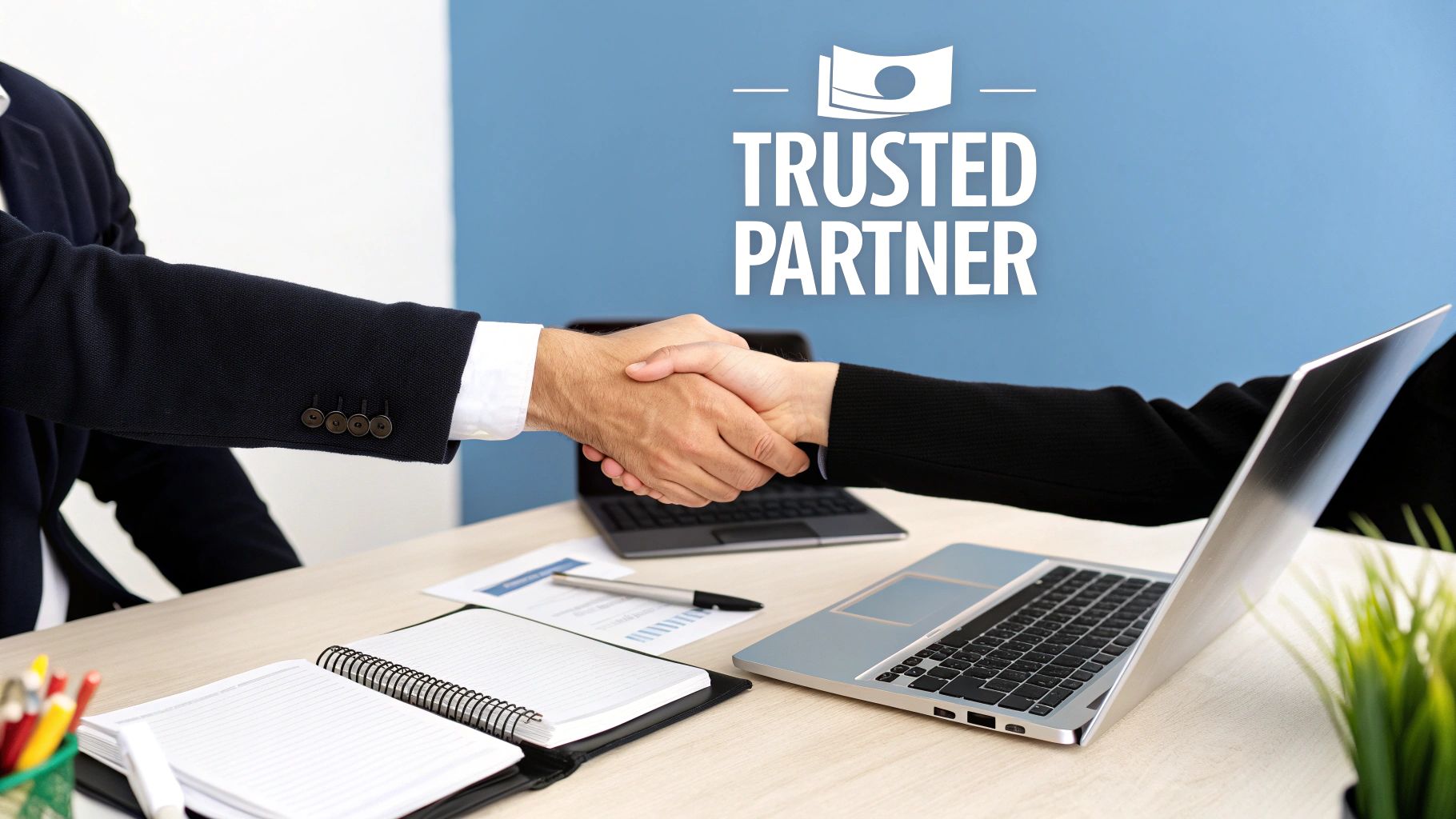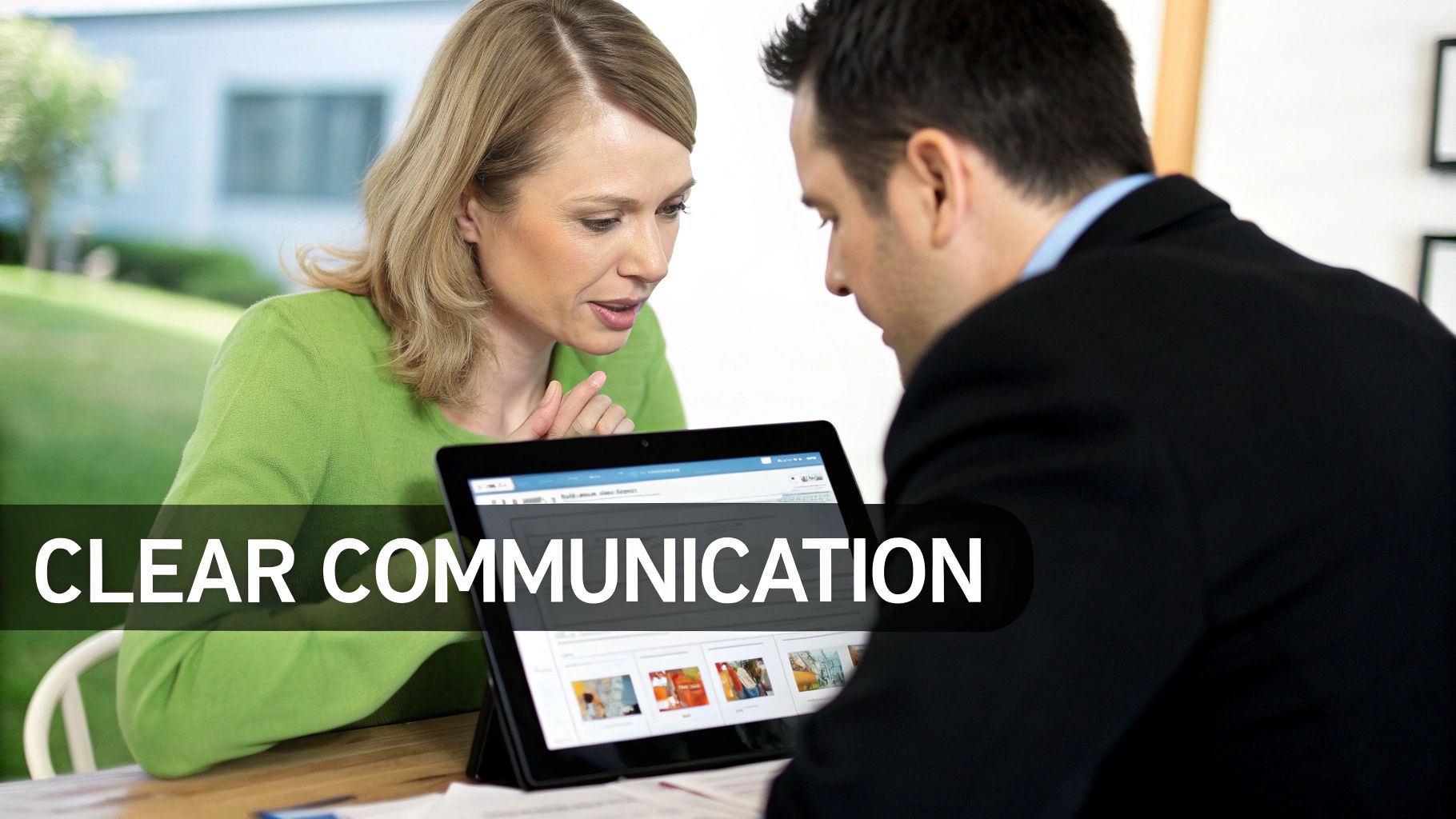Let's be honest, in the creative world, the goal isn't just to be a service provider. It's to become that indispensable partner—the one your client can't imagine working without. This kind of relationship is built on a foundation of mutual trust, open communication, and hitting goals together, right from the very first kickoff meeting.
Why Strong Client Relationships Matter

Before we jump into the "how," let's talk about the "why." Fostering deep loyalty is more than just good business; for a creative agency, it's the engine for sustainable growth. It's what turns one-off projects into predictable, long-term revenue and transforms happy clients into your best marketing channel.
The benefits are real, and they hit your bottom line directly:
- Better Client Retention: When clients see you as a partner, they’ll stick with you through thick and thin and bring you their next big idea.
- Higher Lifetime Value: Trust opens the door to bigger projects and expanded services over time. It's a natural evolution.
- Awesome Referral Business: Happy clients become your biggest fans, sending high-quality leads your way that cost you absolutely nothing to acquire.
- A Stellar Reputation: A portfolio packed with successful, long-term partnerships cements your agency as a go-to expert in your field.
The Financial Impact of Client Experience
Here’s the thing: prioritizing the client experience isn't some fluffy, feel-good strategy. It delivers real, measurable financial results.
Companies that knock it out of the park with their customer experience see their revenue grow about 80% faster than those who let it slide. This just goes to show that focusing on satisfaction and trust is a direct path to business growth. Getting this right from the start is non-negotiable, and it begins with understanding how to earn that trust. A great starting point is this ultimate guide to building trust and winning clients through content marketing.
The goal is to move from a transactional mindset ("What are we delivering this week?") to a strategic one ("How are we helping our client win in the long run?").
This shift in thinking has to happen the second a new client signs on the dotted line. A structured, welcoming start is absolutely crucial, which is why having a solid process is so important.
To help you make an amazing first impression every single time, check out our new client onboarding checklist template at https://creativize.net/blog/new-client-onboarding-checklist-template.
To wrap up this idea, here's a quick look at the core principles that underpin any successful client partnership.
Core Pillars of Strong Client Relationships
This table breaks down the fundamental principles for building and maintaining the kind of client partnerships that last.
| Pillar | Key Action | Expected Outcome |
|---|---|---|
| Mutual Trust | Deliver on promises consistently and operate with transparency. | The client sees you as a reliable and indispensable part of their team. |
| Open Communication | Establish regular check-ins and be proactive with updates (good and bad). | Misunderstandings are minimized, and alignment is maintained throughout. |
| Shared Goals | Define what success looks like together from the beginning. | Everyone is working toward the same objective, creating a true partnership. |
| Proactive Value | Go beyond the brief by offering strategic insights and identifying opportunities. | You become a strategic advisor, not just an order-taker. |
Nailing these four pillars will transform your client relationships from simple transactions into powerful, long-term alliances.
Mastering Proactive and Transparent Communication

Look, great communication is the absolute bedrock of any solid client partnership. And no, I don't just mean sending more emails. It's about a fundamental shift from being reactive to being proactive—getting ahead of your client's needs to build unshakable trust.
Think about it: if a client ever has to ask you for a status update, you've already dropped the ball. You missed a golden opportunity to show them you're in complete control. The real goal is to create a rhythm of communication so reliable they never feel the need to ask. It removes the guesswork and shows you respect their investment.
Set the Stage During Onboarding
The best time to get this sorted is right out of the gate, during client onboarding. Don't leave it to chance. I always recommend creating a shared communication charter. It doesn't have to be some stuffy, formal document—just a simple guide that outlines how, when, and where you'll connect.
Here’s what it should cover:
- Key Contacts: Who’s the go-to person on each side for billing questions? For creative feedback? For technical snags? Map it all out.
- Preferred Channels: Decide where conversations live. Maybe it's email for formal approvals, a shared Slack channel for the quick back-and-forth, and your project management tool for all task updates.
- Response Times: Get real about expectations. A simple "we'll acknowledge all non-urgent emails within 24 business hours" goes a long way.
- Meeting Cadence: Lock in a regular check-in. A quick 30-minute sync every Tuesday can keep everyone aligned without clogging up calendars.
Nailing this down from day one prevents so many future headaches and just makes everything run smoother for both teams. For a deeper look at this, our guide on client communication best practices has some great frameworks to borrow.
Handling Difficult News with Honesty
Sooner or later, every project hits a bump. A deadline is in jeopardy. Scope creep starts rearing its ugly head. How you navigate these moments is what separates the good agencies from the great ones. The trick is to tackle problems head-on, with total transparency and a solid plan.
Never, ever hide bad news. It only gets worse. The key is to frame it constructively.
When you have to deliver tough news, always pair the problem with a proposed solution. It instantly shifts the conversation from blame to collaborative problem-solving.
For instance, instead of a panicked, "We're behind schedule," try leading with a solution-focused approach:
"Hey team, I want to flag a potential risk to our timeline. That extra feedback round added three days to the design phase. To get us back on track, my suggestion is we could either condense the next revision cycle a bit, or we could push the final launch date by three days. Which of those options feels better for you?"
See the difference? This approach shows you're taking ownership, it gives the client agency in the decision, and it reinforces that you're a strategic partner, not just a vendor reporting a problem. This is how you build the kind of trust that can weather any storm.
Using Technology to Personalize Client Interactions

This chart isn't just a bunch of lines going up; it’s a story about how businesses are leaning hard into tech to manage their client relationships. And for good reason. The right tools don't just make you faster; they give you the power to create a genuinely personal experience, even as you scale.
Turn Your CRM Into an Intelligence Hub
Most of us have a Customer Relationship Management (CRM) tool, but let's be honest, it's often just a glorified digital Rolodex. It’s time to stop scratching the surface and treat it like your agency's central brain—a hub for client intelligence.
The real magic happens when you track the little details that show you’re actually paying attention.
Your CRM needs to go way beyond just contact info and deal stages. Start creating custom fields that capture the stuff that really matters to your clients. Think about tracking things like:
- Key Dates: Note their company's anniversary or even the anniversary of when you started working together. A quick "Happy Anniversary!" email is a small gesture that shows you value their journey.
- Communication Preferences: Does your client live on Slack, or are they more of a formal email person? Do they prefer quick weekly summaries or deep-dive bi-weekly calls? Documenting this means everyone on your team can connect in a way the client actually appreciates.
- Personal Details: Jot down notes from your calls. Did they mention their dog's name? A favorite sports team? An upcoming vacation? Slipping these details into future conversations makes your interactions feel less transactional and way more human.
This kind of proactive data gathering proves you see them as more than just an account number.
Automate the Routine, Not the Relationship
Look, automation is your friend, but only for the right things. Its job is to clear your plate of the boring, administrative stuff so you have more time for high-value strategic conversations—not to replace them.
A perfect example is using scheduling tools to kill the endless back-and-forth of finding a meeting time. Nailing your Outlook Google Calendar sync can wipe out scheduling headaches and show your client you’re all about efficient collaboration.
Technology should handle the logistics, so you can handle the relationship. Automate appointment reminders, follow-ups for unsigned documents, and invoicing, but never, ever automate a 'thank you' or a strategic check-in.
These tools are becoming non-negotiable. The global CRM market was valued at USD 70.2 billion in 2024 and is projected to skyrocket to USD 178.7 billion by 2034. That surge is all about businesses like yours finding smarter ways to elevate how they connect with customers.
By thoughtfully weaving technology into your workflow, you build a system that supports and amplifies your relationship-building efforts, making sure every single client feels uniquely valued.
Delivering Value Beyond the Statement of Work

The strongest client relationships aren't just built on fulfilling a contract. They're forged when you evolve from a service provider into a true, indispensable partner. That shift happens when you consistently deliver value that isn't listed on the SOW.
It’s all about proving you’re genuinely invested in their success, not just in checking off the current project's to-do list.
This doesn't mean you should start working for free or letting scope creep run wild. Not at all. It’s about the thoughtful, strategic gestures that show you’re thinking about their business even when the clock isn't ticking. These small actions build a mountain of trust over time.
Become an Extension of Their Team
Your real goal is to become an ally—someone who gets their challenges and proactively looks for opportunities for them. When you adopt this mindset, every single interaction changes for the better.
Here are a few tangible ways to start adding value beyond the official deliverables:
- Share Curated Intel: See an industry report or an article about a new trend that could affect their business? Don't just forward it. Send it over with a quick, personalized note: "Saw this and thought of you. The data on page 4 about Gen Z's media habits could be a killer angle for our Q3 campaign."
- Make Strategic Introductions: Your network is one of your most powerful assets. If you know a rockstar web developer or a PR specialist who could help another part of their business, offer to connect them. When you facilitate valuable relationships, you become a trusted, central figure in their world.
- Offer Unsolicited Ideas: Every now and then, send a quick video message or a brief email with a creative spark. Something simple like, "I was just brainstorming and had a thought—what if we repurposed last month's video assets for a killer TikTok series? No need to act on it, just planting a seed!"
That kind of proactive thinking shows you're always looking out for their best interests.
When you actively contribute to a client’s success beyond your contractual obligations, you stop being an expense and become a high-return investment.
That mental shift is everything. It's the difference between being the first vendor cut during a budget review and being the last partner they’d ever dream of letting go.
Conduct Informal Business Check-Ins
Every so often, schedule a quick, informal call with no agenda other than to see what's happening in their world. These are not project status meetings. They are relationship-building conversations, and the insights you can gain from them are pure gold.
Try asking a few open-ended questions like:
- "What are the biggest challenges your team is wrestling with right now?"
- "What does a huge win look like for you in the next six months?"
- "Are there any shifts in the market that are making you nervous?"
And then, just listen. The more you understand their evolving pain points, the more you can proactively suggest solutions, even if they don't lead to immediate new work. This solidifies your role as a trusted advisor. By focusing on their bigger picture, you also make the process of managing client expectations on individual projects much smoother, since they know you’re aligned with their ultimate goals.
Turning Difficult Conversations into Trust-Building Moments
Look, no project is perfect. No matter how much you plan, things will go sideways. A deadline gets blown, a budget creeps up, or a creative concept just completely misses the mark. It happens.
But these moments don’t have to be disasters. In fact, handled the right way, they can actually make your client relationship stronger. It’s all about how you navigate the friction.
When something goes wrong, the very first thing you need to do is own it. Immediately and completely. No deflecting, no excuses, and please, no corporate-speak trying to soften the blow.
A simple, direct, “You’re right, we missed this, and I take full responsibility” is one of the most powerful phrases in your arsenal. It instantly diffuses tension and starts rebuilding trust.
From Problem to Plan
Just saying "sorry" isn't enough, though. Acknowledging the problem is just the first step. What a client really needs to see is that you have a concrete plan to make things right. That’s what restores their confidence.
Your plan needs to be specific and proactive. "We'll fix it" is vague and unhelpful.
Let’s say you delivered some copy that was way off-brand. Instead of a generic promise, try this:
- Acknowledge the specifics: "We completely agree. The first draft of the copy lacked that energetic tone we were all aiming for."
- Outline your immediate action: "Our lead copywriter is clearing her schedule to tackle a full rewrite, starting this afternoon."
- Give them a hard deadline: "You will have a completely new version in your inbox by 10 AM tomorrow. Guaranteed."
See the difference? This approach swaps their anxiety for assurance. You’re no longer the agency that messed up; you’re the capable problem-solver who has the situation under control. Dealing with these situations head-on is a skill, and you can get more structured advice on how to deal with demanding clients in our in-depth guide.
Honestly, navigating a crisis with transparency and skill can build more trust than a flawless project ever could. It proves you're a reliable partner when the pressure is on.
Over-Deliver on the Recovery
Once you’ve laid out the recovery plan, the final piece is to knock it out of the park. Don't just meet the new deadline—beat it if you can.
Then, add a little something extra to show goodwill. This doesn’t have to be huge. Maybe you provide two fantastic creative options instead of the one you promised. Or you could include a quick report outlining the process changes you're making to ensure it never happens again.
This focus on data and improvement is what separates the pros from the amateurs. It’s no surprise that North America held around 42.8% of the global CRM market share in 2024. Businesses here are obsessed with using data to build stronger relationships.
By learning from your missteps, you’re not just fixing a problem; you’re building a more resilient, transparent partnership. That final gesture is what turns a potential client catastrophe into a lasting positive memory.
Common Questions About Building Client Relationships
Even with the best game plan, weird situations are going to pop up. It’s just the nature of the business. These moments are what really test the strength of your client partnerships.
Let's dive into some of the most common questions that come up when you’re figuring out how to build client relationships that actually last.
How Often Should I Communicate with My Clients?
There’s no magic number here. The real goal is consistency over frequency.
The right cadence depends entirely on the project's complexity and your client's personality, something you should nail down during the onboarding process. A weekly summary email paired with a bi-weekly strategy call is a solid starting point for most. For those high-intensity, all-hands-on-deck projects, you might need a quick daily check-in on your project management tool.
The key is to set a predictable rhythm. You want them to never feel the need to chase you for an update. Be more proactive than they expect.
What Is the Best Way to Handle a Difficult Client?
First, take a breath. Before you react, try to understand where they're coming from. Is the client getting heat from their own boss? Did we miss something in our communication, or were expectations fuzzy from the get-go?
Whatever you do, don't get into an email war. Get them on a call and just listen. Let them air it all out without getting defensive.
Gently bring the conversation back to the boundaries and communication rules you both agreed to. It's always a good idea to document these key conversations so everyone’s on the same page. If things are still a huge drain on your team's morale after all that, it might be time for a frank chat about whether the partnership is a good long-term fit for either of you.
The most productive way to handle a difficult client is to shift the focus from their frustration to a collaborative search for a solution. It changes the dynamic from "us vs. them" to "us vs. the problem."
How Can I Rebuild Trust After Making a Mistake?
When you mess up, you have to act fast. Trust is rebuilt with immediate, transparent, and decisive action. There's a simple, three-part playbook for this.
- Own It Immediately: Take full responsibility. No excuses. A simple, "You're right, we dropped the ball here," is incredibly powerful.
- Present a Clear Plan: Explain exactly what happened, what you’re doing right now to fix it, and what you’re putting in place so it never, ever happens again.
- Over-Deliver on Your Next Steps: Meet your new promises and then some. Consistent, dependable action is the only thing that truly restores a client's confidence.
Getting this right shows you’re reliable even when things get tough, which, funny enough, can end up making the relationship even stronger.
How Do I Ask for Feedback Without Seeming Insecure?
It's all in the framing. You want to position your request for feedback as a tool for improving the partnership, not as a desperate plea for validation. This makes you look like a strategic ally who’s focused on their success, not just your own report card. Getting this right is a huge part of your long-term success; our guide on how to retain clients has a lot more on creating these positive feedback loops.
Instead of a vague, "So… are you happy with our work?" try asking something more specific and forward-looking.
- "As we plan for the next quarter, what’s the single most important outcome for your team?"
- "What is one thing we could do next month that would make your job easier?"
This approach gets you actionable insights and reinforces your role as a proactive partner who’s genuinely invested in their growth.
At Creativize, we believe strong relationships are the bedrock of great creative work. Our platform is built to help you connect with the right local talent to build the kind of partnerships that get real results. Discover your next creative partner at https://creativize.net.

